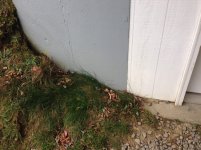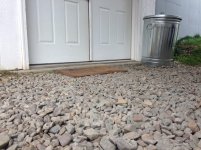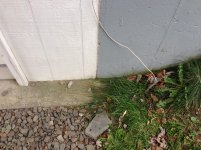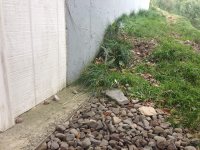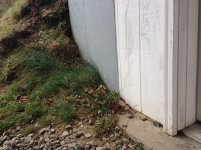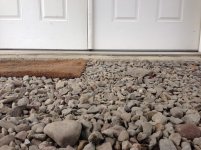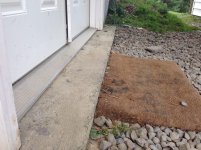jrdepew
Silver Member
All,
I have a ranch with a walkout basement in rainy upstate NY. When the house was first built there was a basement garage entrance and the original owner parked his car in the basement. At some point in the past, the garage door was removed, the opening was framed in with 2x4's, and a large set of double doors was installed. These operate like french doors, so there is a huge opening when both are open. This is very nice for moving large objects in/out of the basement. There is also a covered walkway over the door leading to the garage about 8' away. The problem I noticed since I bought the house is that heavy driving rain will still soak the doors and the water weeps under the door frame and wooden frame around it. I can now see mold starting at the bottom of the framing. Finally, the way the door is anchored is poor at best, and the doors to not feel sturdy when closing them. All in all...this was a little bit of a hack job.
This spring I want to replace the moldy 2x4 framing and weak door with a sturdier, more weatherproof setup. My plan right now is to rip the whole existing assembly out. Depending on how the bottom plate was mounted to the concrete, I may be drilling holes and dropping anchors to attach the new bottom plate. Here is my initial plan and some questions:
1. Use all 2x6 framing, so I can better insulate and have a sturdier structure when complete.
2. To seal the base board, I was going to use closed cell foam that is sold for sealing rim-joists in new construction laid down first. Should I skip the foam and use a sealing adhesive here instead? Foam and adhesive? I am mostly worried about sealing against water intrusion at this gap.
3. For the base board, should I just use 2x6PT pine? Alternatively, I could use a piece of plastic decking like azek, then a piece of PT pine on top. This would ensure that no wood was coming into constant contact with water. The rest of the framing will most likely be 2x6PT since this is a relatively small area to frame and I want to avoid any chance of mold. I have never framed with metal studs before, but this may be a good application?
4. Insulation...I was going to use foam board cut to fit the joist cavities and then glued in place with greatstuff foam. Again...nothing to stay wet and get moldy.
5. Doors...I am lost here. I would like to stay with the current style of door if possible, as the wide opening is very nice when I am carrying coal into the basement, carrying wood into the basement. Does anyone have any good suggestions on a nice set of exterior steel clad double doors?
6. Exterior...currently this is painted T111 style siding. I am fine with this look and the siding seems to be holding up very well...I will know more once I start working. I think siding to match the house would look bad here..and I am not sure what else I could use to be honest.
Any other materials I could use to frame/insualte/etc? I am really open to suggestions here and since I will be pulling the current framing out I will be starting from scratch with a concrete floor and poured concrete walls. I have even been pondering doing masonry. Again, this is in the very initial planning stages and I would like to begin in spring once we can get a string of warmer days.
I will get some pictures of the area posted up soon.
Thanks in advance for any suggestions!
Joe
I have a ranch with a walkout basement in rainy upstate NY. When the house was first built there was a basement garage entrance and the original owner parked his car in the basement. At some point in the past, the garage door was removed, the opening was framed in with 2x4's, and a large set of double doors was installed. These operate like french doors, so there is a huge opening when both are open. This is very nice for moving large objects in/out of the basement. There is also a covered walkway over the door leading to the garage about 8' away. The problem I noticed since I bought the house is that heavy driving rain will still soak the doors and the water weeps under the door frame and wooden frame around it. I can now see mold starting at the bottom of the framing. Finally, the way the door is anchored is poor at best, and the doors to not feel sturdy when closing them. All in all...this was a little bit of a hack job.
This spring I want to replace the moldy 2x4 framing and weak door with a sturdier, more weatherproof setup. My plan right now is to rip the whole existing assembly out. Depending on how the bottom plate was mounted to the concrete, I may be drilling holes and dropping anchors to attach the new bottom plate. Here is my initial plan and some questions:
1. Use all 2x6 framing, so I can better insulate and have a sturdier structure when complete.
2. To seal the base board, I was going to use closed cell foam that is sold for sealing rim-joists in new construction laid down first. Should I skip the foam and use a sealing adhesive here instead? Foam and adhesive? I am mostly worried about sealing against water intrusion at this gap.
3. For the base board, should I just use 2x6PT pine? Alternatively, I could use a piece of plastic decking like azek, then a piece of PT pine on top. This would ensure that no wood was coming into constant contact with water. The rest of the framing will most likely be 2x6PT since this is a relatively small area to frame and I want to avoid any chance of mold. I have never framed with metal studs before, but this may be a good application?
4. Insulation...I was going to use foam board cut to fit the joist cavities and then glued in place with greatstuff foam. Again...nothing to stay wet and get moldy.
5. Doors...I am lost here. I would like to stay with the current style of door if possible, as the wide opening is very nice when I am carrying coal into the basement, carrying wood into the basement. Does anyone have any good suggestions on a nice set of exterior steel clad double doors?
6. Exterior...currently this is painted T111 style siding. I am fine with this look and the siding seems to be holding up very well...I will know more once I start working. I think siding to match the house would look bad here..and I am not sure what else I could use to be honest.
Any other materials I could use to frame/insualte/etc? I am really open to suggestions here and since I will be pulling the current framing out I will be starting from scratch with a concrete floor and poured concrete walls. I have even been pondering doing masonry. Again, this is in the very initial planning stages and I would like to begin in spring once we can get a string of warmer days.
I will get some pictures of the area posted up soon.
Thanks in advance for any suggestions!
Joe




